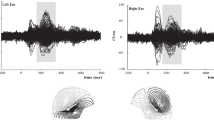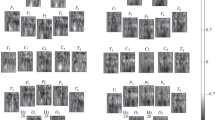Abstract
Several studies have found that P3 amplitude of the auditory event-related potential is smaller in autistic than in normal children. The present study investigated whether this characteristic bears any relationship to the degree of language impairment and/or level of intellectual ability of autistic persons. Seventeen autistic children, ranging from 8–19 years of age, and 17 age- and gender-matched normal children participated. Event-related potentials to phonetic (“Da”) and chord (piano) stimuli were recorded from three scalp locations: vertex (Cz), right hemisphere (RH), and left hemisphere (LH), during a discrimination task. A battery of language tests was given to autistic children. Compared to normal subjects, autistic subjects showed a significantly smaller P3 amplitude to phonetic stimuli for Cz and LH recording sites. However, no group difference in P3 amplitude to the phonetic stimulus was found for the RH. Furthermore, no group differences in P3 amplitude were found for the chord stimulus at any recording site. Impaired language ability was related to greater RH P3 amplitude, particularly to the chord stimulus. The possibility of differential hemispheric involvement in the attentional deficits of autistic children is raised.
Similar content being viewed by others
References
Courchesne, E., Kilman, B. A., Galambos, R., & Lincoln, A. J. (1984). Autism: Processing of novel auditory information assessed by event-related brain potentials.Electroencephalography and Clinical Neurophysiology, 59, 238–248.
Courchesne, E., Lincoln, A. J., Kilman, B. A., & Galambos, R. (1985) Event-related brain potential correlates of the processing of novel visual and auditory information in autism.Journal of Autism and Developmental Disorders, 15, 55–76.
Danier, K. B., Klorman, R., Salzman, L. F., Hess, D. W., Davidson, P. W., & Michael, R. L. (1981). Learning disordered children's evoked potentials during sustained attention.Journal of Abnormal Child Psychology, 9, 79–84.
Dawson, G. (1987). The role of abnormal hemispheric specialization in autism. In E. Schopler & G. Mesibov (Eds.),Neurobiological issues in autism. New York: Plenum Press.
Dawson, G. (in press). Cerebral lateralization in autism: Clues to its role in language and affective development. In S. Segalowitz & D. Molfese (Eds.),Developmental implications of brain lateralization. New York: Guilford.
Dawson, G., Warrenburg, S., & Fuller, P. (1982). Cerebral lateralization in individuals diagnosed as autistic in early childhood.Brain and Language, 15, 353–368.
Dawson, G., Warrenburg, S., & Fuller, P. (1983). Hemisphere functioning and motor imitation in autistic persons.Brain and Cognition, 2, 346–354.
DeMyer, M. K., Barton, S., Alpern, G. D., Kimberlin, C., Allen, J., Yang, E., & Steele, R. (1974). The measured intelligence of autistic children: A follow-up study.Journal of Autism and Childhood Schizophrenia, 4, 42–60.
Fein, D., Skoff, B., & Mirsky, A. F. (1981). Clinical correlates of brain dysfunction in autistic children.Journal of Autism and Developmental Disorders, 11, 303–315.
Holcomb, P. J., Ackerman, P. T., & Dykman, R. A. (1985). Cognitive event-related brain potentials in children with attention and reading deficits.Psychophysiology, 22, 656–667.
Kinsbourne, M. (1987). Cerebral-brainstem relations in infantile autism. In E. Schopler & G. Mesibov (Eds.),Neurobiological issues in autism. New York: Plenum Press.
Lockyer, L., & Rutter, M. (1970). A five to fifteen year follow-up study of infantile psychosis: IV. Patterns of cognitive ability.British Journal of Social and Clinical Psychology, 9, 1952–1963.
Loiselle, D., Stamm, J. S., Maitincky, S., & Whipple, S. C. (1980). Evoked potential and behavioral signs of attention dysfunction in hyperactive boys.Psychophysiology, 17, 193–201.
Martineau, J., Garreau, B., Barthelemy, C., & LeLord, G. (1984). Evoked potentials and P300 during sensory conditioning in autistic children. In J. Cohen & P. Tueting (Eds.),Brain and information: Event-related potentials (pp. 362–369). New York: New York Academy of Sciences.
Novick, B., Kurtzberg, A., & Vaughan, H. G., Jr. (1979). An electrophysiologic indication of defective information storage in childhood autism.Psychiatry Research, 1, 101–108.
Novick, B., Vaughan, H. G., Jr., Kurtzberg, D., & Simon, R. (1980). An electrophysiological indication of auditory processing defects in autism.Psychiatry Research, 3, 107–114.
Posner, M. (1978).Chronometric explorations of mind. Hillsdale, NJ: Erlbaum.
Prior, M. R., & Bradshaw, J. L. (1979). Hemisphere functioning in autistic children.Cortex, 15, 73–81.
Ruchkin, D. S., & Sutton, S. (1978). Equivocation and the P300 amplitude. In D. A. Otto (Ed.),Multidisciplinary perspectives in event-related brain potential research (EPA-600/9-77-043). Washington, DC: Environmental Protection Agency.
Ruff, R. (1977).BABBLE speech processing program. Unpublished masters thesis, University of North Carolina, Chapel Hill.
Small, J. G., DeMyer, M. K., & Milstein, V. (1971). CNV responses of autistic and normal children.Journal of Autism and Childhood Schizophrenia, 1, 215–231.
Wetherby, A. M., Koegal, R. L., & Mendel, M. (1981). Central auditory nervous system dysfunction in echolalic autistic individuals.Journal of Speech and Hearing Research, 24, 420–429.
Author information
Authors and Affiliations
Additional information
The present study was supported by National Institute of Mental Health Grant No. MH33612 awarded to Geraldine Dawson. The authors thank the autistic children and their families, and the staff at Division TEACCH for their many hours of cooperation. Drs. Harold Pillsbury and Grady Thomas, Department of Surgery, School of Medicine, UNC-CH, generously made available the auditory evoked-response equipment and laboratory. Teresa Frei, Mary Evers, Karen Cotten, Mary Hyde, and Joan Keyser assisted in data collection and scoring. Faulder Colby and Chris Gullion helped with data analyses. Clarrisa Brame, Sallie McCarthy, and Kathrinn Fitzpatrick provided secretarial support.
Rights and permissions
About this article
Cite this article
Dawson, G., Finley, C., Phillips, S. et al. Reduced P3 amplitude of the event-related brain potential: Its relationship to language ability in austism. J Autism Dev Disord 18, 493–504 (1988). https://doi.org/10.1007/BF02211869
Issue Date:
DOI: https://doi.org/10.1007/BF02211869




